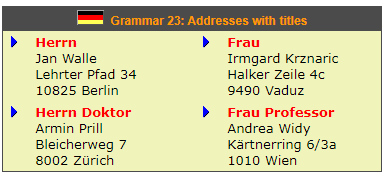1. Position of the address
Your own address should be the first element of the letter, and you can include your telephone number, fax number and/or E-mail address at the end of this, if you are willing to be contacted in this way. Leave a gap and then type in the address of the person or company to whom you are writing.
Note that whilst telephone numbers are said in pairs, they are written in a business letter as only two numbers, the regional dialling code followed by the actual number. If you are writing from overseas, remember to add the international dialling code.
Both addresses should be positioned flush left on your page and should not contain commas at the end of each line.

Notes
1. Why is it "Herrn" and not "Herr"? Because you are writing to the man in question, and he is thus in the accusative case. As we have seen in this chapter, "Herr" is a weak masculine noun and thus adds an extra "-n" in all cases other than the nominative singular.
2. If the person to whom you are writing has a title such as "doctor" or "professor", this title is preceded on the first line of the address by either "Herrn" or "Frau" depending on the gender of the addressee.
3. In many cases, the masculine form of the title is used regardless of the gender of the person possessing this title - e.g. "Frau Doktor", "Frau Professor". With some other titles however, the feminine form is used for a female addressee - e.g. "Frau Studienrätin" (= secondary school teacher).
 英语
英语 日语
日语 韩语
韩语 法语
法语 西班牙语
西班牙语 意大利语
意大利语 阿拉伯语
阿拉伯语 葡萄牙语
葡萄牙语 越南语
越南语 俄语
俄语 芬兰语
芬兰语 泰语
泰语 丹麦语
丹麦语 对外汉语
对外汉语

